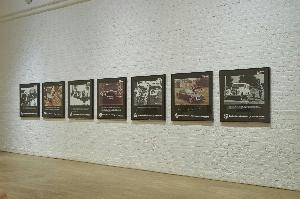Hans Haacke
Hans Haacke
Style: Conceptual Art;
Place: Cologne
Born: 1936
Biography:
Hans Haacke is a German-born artist who lives and works in New York City. Haacke is considered a 'leading exponent' of Institutional Critique. He studied at the Staatliche Werkakademie in Kassel, Germany, from 1956 to 1960. In 1959, Haacke was hired to assist with the second documenta, working as a guard and tour guide. He was a student of Stanley William Hayter, a well-known and influential English printmaker, draftsman, and painter. From 1961 to 1962, he studied on a Fulbright grant at the Tyler School of Art at Temple University in Philadelphia. From 1967 to 2002, Haacke was a professor at the Cooper Union in New York City. During his formative years in Germany, he was a member of Zero (an international group of artists, active ca. 1957–1966). This group was held together with common motivations: the longing to re-harmonize man and nature and to restore art's metaphysical dimension. They sought to organize the pictorial surface without using traditional devices. Although their methods differed greatly, most of the work was monochromatic, geometric, kinetic, and gestural. But most of all they used nontraditional materials such as industrial materials, fire and water, light, and kinetic effects. The influence of the Zero group and the materials they used is clear in Haacke's early work from his paintings that allude to movement and expression to his early installations that are formally minimal and use earthly elements as materials. These early installations focused on systems and processes. Condensation Cube (1963–65) embodies a physical occurrence, of the condensation cycle, in real time. Some of the themes in these works from the 1960s include the interactions of physical and biological systems, living animals, plants, and the states of water and the wind. He also made forays into land art, but by the end of the 1960s, his art had found a more specific focus. Haacke's interest in real-time systems propelled him into his criticism of social and political systems. In most of his work after the late 1960s, Haacke focused on the art world and the system of exchange between museums and corporations and corporate leaders; he often underlines its effects in site-specific ways. Haacke has been outspoken throughout his career about demystifying the relationship between museums and businesses and their individual practices. He writes, 'what we have here is a real exchange of capital: financial capital on the part of the sponsors and symbolic capital on the part of the sponsored'. Using this concept from the work of Pierre Bourdieu, Haacke has underlined the idea that corporate sponsorship of art enhances the sponsoring corporations' public reputation, which is of material use to them. Haacke believes, moreover, that both parties are aware of this exchange, and as an artist, Haacke is intent on making this relationship clear to viewers.



